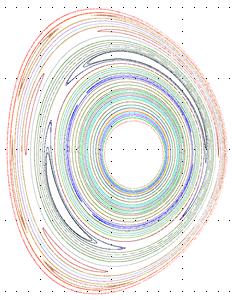

A cross-section of the virtual plasma showing where the magnetic field lines intersect the plane. The central section has field lines that rotate exactly once.
Credit: Stephen Jardin, PPPL
The team, which included scientists from General Atomics and the Max Planck Institute for Plasma Physics, performed calculations on the Edison computer at the National Energy Research Scientific Computing Center, a division of the Lawrence Berkeley National Laboratory.
Using M3D-C1, a program they developed that creates three-dimensional simulations of fusion plasmas, the team found that under certain conditions a helix-shaped whirlpool of plasma forms around the center of the tokamak. The swirling plasma acts like a dynamo — a moving fluid that creates electric and magnetic fields. Together these fields prevent the current flowing through plasma from peaking and crashing.
The researchers found two specific conditions under which the plasma behaves like a dynamo. First, the magnetic lines that circle the plasma must rotate exactly once, both the long way and the short way around the doughnut-shaped configuration, so an electron or ion following a magnetic field line would end up exactly where it began.
Second, the pressure in the center of the plasma must be significantly greater than at the edge, creating a gradient between the two sections. This gradient combines with the rotating magnetic field lines to create spinning rolls of plasma that swirl around the tokamak and gives rise to the dynamo that maintains equilibrium and produces stability.
This dynamo behavior arises only under certain conditions. Both the electrical current running through the plasma and the pressure that the plasma's electrons and ions exert on their neighbors must be in a range that is “not too large and not too small,” said Jardin. In addition, the speed at which the conditions for the fusion reaction are established must be “not too fast and not too slow.”
Jardin stressed that once a range of conditions like pressure and current are set, the dynamo phenomenon occurs all by itself. “We don't have to do anything else from the outside,” he noted. “It's something like when you drain your bathtub and a whirlpool forms over the drain by itself. But because a plasma is more complicated than water, the whirlpool that forms in the tokamak needs to also generate the voltage to sustain itself.”
During the simulations the scientists were able to virtually add new diagnostics, or probes, to the computer code. “These diagnostics were able to measure the helical velocity fields, electric potential, and magnetic fields to clarify how the dynamo forms and persists,” said Jardin. The persistence produces the “voltage in the center of the discharge that keeps the plasma current from peaking.”
Physicists have indirectly observed what they believe to be the dynamo behavior on the DIII-D National Fusion Facility that General Atomics operates for the Department of Energy in San Diego and on the ASDEX Upgrade in Garching, Germany. They hope to learn to create these conditions on demand, especially in ITER, the huge multinational fusion machine being constructed in France to demonstrate the practicality of fusion power. “Now that we understand it better, we think that computer simulations will show us under what conditions this will occur in ITER,” said Jardin. “That will be the focus of our research in the near future.”
Learning how to create these conditions will be particularly important for ITER, which will produce helium nuclei that could amplify the sawtooth disruptions. If large enough, these disruptions could cause other instabilities that could halt the fusion process. Preventing the cycle from starting would therefore be highly beneficial for the ITER experiment.
###
PPPL, on Princeton University's Forrestal Campus in Plainsboro, N.J., is devoted to creating new knowledge about the physics of plasmas — ultra-hot, charged gases — and to developing practical solutions for the creation of fusion energy. Results of PPPL research have ranged from a portable nuclear materials detector for anti-terrorist use to universally employed computer codes for analyzing and predicting the outcome of fusion experiments. The Laboratory is managed by the University for the U.S. Department of Energy's Office of Science, which is the largest single supporter of basic research in the physical sciences in the United States, and is working to address some of the most pressing challenges of our time. For more information, please visit science.energy.gov.












